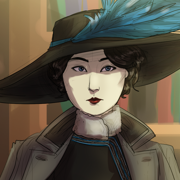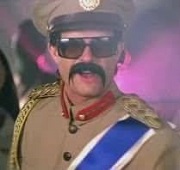|

|
|
|
|

|
| # ? Jun 4, 2024 22:39 |
|
holy poo poo.
|
|
|
|
Technowolf posted:An infinitely repeating fractal of pyramids The first national flag to feature a Sierpinski triangle
|
|
|
|
|
|
|
|
Freudian posted:The first national flag to feature a Sierpinski triangle Consider...flag that *is* a Sierpinski Triangle 
|
|
|
|
This is incredible. Added to the OP. 
|
|
|
|
 We can also import the use of tzompantlis from the Americas for that extra level of
|
|
|
|
Amazing
|
|
|
|
So. After we’re done ruining the Empire’s day, where next? Across the sea? Seems like a decent idea.
|
|
|
|
HereticMIND posted:So. After we’re done ruining the Empire’s day, where next? Across the sea? Seems like a decent idea. Awiropa yearns for freedom from their colonial overlords
|
|
|
|
HereticMIND posted:So. After we’re done ruining the Empire’s day, where next? Across the sea? Seems like a decent idea. Gotta get revenge on Anatolia first.
|
|
|
|
Anatolia won the great republic fight fair and square. I think we are supposed to listen to whatever dumb scheme they come up with.
|
|
|
|
karmicknight posted:I think we are supposed to listen to whatever dumb scheme they come up with. that same Lasya cartoon edit, except with "no... hahaha no"
|
|
|
|
We are the junior republic now, we have the diploma that says "you tried" and everything.
|
|
|
|
karmicknight posted:We are the junior republic now, we have the diploma that says "you tried" and everything. 
|
|
|
|
That is the best picture of this entire LP. Hands down.
|
|
|
|
Chapter 83: 1775 to 1780 - The Last Empress From Weikepedia 维科百科, the Free Encyclopedia Lasya (Sanskrit लास्य, Mandarin, 拉西亞; 9 January 1343 – 3 May 1417), was a Tibetan-Mongol empress and conqueror. Her reign was marked by ambitious plans for imperial expansion, with rapid campaigns against the Third Han Dynasty and the Mongolian Empire. While the entirety of the Han Dynasty was conquered within five years, and the Mongolian Empire was fought to a standstill, plans for further conquest were stymied by massive domestic rebellions led by noble families and separate branches of the Purgyal Dynasty. Lasya was the last of the great semi-nomadic conquerors of the Eurasian Steppe, and her empire saw parallel developments in the Timurid Empire to Tibet's west, the Anatolian Empire, and other such 'gunpowder empires' in the 16th and 17th centuries. Lasya was of both Tibetan and Mongol descent, and, while not a direct descendant on either side, she shared a common ancestor with Gyalyum the Benevolent on her mother's side, while other authors have suggested that her mother might have been a relation of Temulun Khatun. She clearly sought to invoke the legacy of the both their conquests in her lifetime. In public declarations, Lasya envisioned the restoration of a Tibetan Empire. Lasya was considered a great patron of art and natural philosophy, as she supported the work of contemporary theologians and natural philosophers such as Esclarmonde of Itarhia. Her legacy is mixed, with liberals in the 18th and early 19th century considering her as an icon of anti-aristocratic sentiment, and later generations of nationalists celebrating her conquests and the 'great unity' of the Empire. By contrast, later revisionist historians stated that her military campaigns hastened the collapse of the Tibetan Empire, and her life has generated considerable historical controversy. She has been called alternately 'the Last Empress', or 'the Founder of Modern Tibet'.  No. You've read enough. You know who I am. You voted for me, after all. Of all the rulers and sacred presences of Tibet's past, you went for me. Many of the other royals' tombs have been picked clean by now, but not mine. You know who not to upset. The Empire is dead, as they say. The Republic, they think, may die in its swaddling clothes. And now you invoke my name, leave offerings to my image, and make my ghost walk again. I have the books of knowledge and all earthly things, I will see what history has made, how I have made it for you.  (Lasya the Holy, artist's depiction.) Art by Empress Theonora I will go no further. I'm sure I'm not the only ghost to you, nor the only one that people think they've seen. Just because people think they stabbed Pakmodru Tse to death a hundred times, that doesn't mean she's stopped breathing, she escaped after burial and she's off around the Himalaya somewhere, held together with bandages and prayed to by lovers and the lost. And just because you think they dug up the last person in this godforsaken country that called herself Empress and put her on trial doesn't mean her spirit is undisturbed; the remains vanished after being shoved back in a sherpa's pack somewhere and her soul is howling at the rocks and ghosts. And you know who I am.  The Republic, as I see it, is not the Empire as it was. It much smaller, yet with the clans and noble families cut out of its heart for the time being. So many vassal kings, all gone now. Though someone will try and replace them. Somebody will be like the listless scoundrels of my own time, picking at flies because they have nothing else to do.  The republic aspires for the loyalty of every citizen, and not of the clan or name.  The territory is vast, and there are little areas of prosperity and commerce in it,  but must still be managed and controlled, every new district measured and put right.  We are far removed from the days of the four horns, when Tibet itself was only a part of the Yarlung Tsangpo valley and fought Sumpa and Zhangzhung.  And in my age, the empire was said to be vast, and any map of it, drawn by some scholar, would be limitless.  But the empire buckles under its own weight, the cities were too numerous to be counted. Too numerous for my own dreams, and what I fought against as much as any other empire, was the aristocracy over how to rule it. It would be a dream of mine, I admit, to clean up the map and replace it with ordered provinces. Combatting my own opponents, hidden in every shadow, and replacing everything else with what needs to be done.  And now they are gone. And the parliament asserts itself - a yak herder, a tile maker, a ship owner, a printing shop boss, a county judge. So many seats reserved for priests. Some of them quote their works of philosophy, saying that the only motivation for people is self-interest. It is not so simple.  I, too, walked in the noisy halls of parliament, relishing at the chance to see what the people decided for themselves. They swing back and forth like a pendulum. I made a few suggestions, of course, but I'm happy with what they've done for themselves and came up with on their own. Having formed a system of government where they stopped killing each other for the time being and only shout, the new parliament decides that its old enemy, the landed aristocracy to the south, must be destroyed, and the empire dismantled. The business is concluded, they think.  Well, they thought. So here is what one may assume happens. After so the failed war against Anatolia, still more and more enemies declare war on Tibet, circling around like the thieves along the road attacking a messenger. And history itself becomes a filthy slaughterhouse. And then there is nothing left but a few squabbling warlords, as separate as scattered bones. Where exactly do you think we are? Many of them prayed to me, even those that say they didn't.  Or, if I was part of the Sacred Empire, I'd think this: a sleeping demon still lumbers north of the Himalaya, and it must be slain before its gaze turned south. The Sacred Empire too is great, prosperous, let us not take the task of conquest too lightly. We cannot burst it like an old water sac. The nobility of the world, especially the neighbors of Tibet or Anatolia, ask themselves: what must we do before this thing called the people raises their fists against them? I admit I am sympathetic to the republic. 'Why is this?' you ask. First, we share a common enemy in the aristocracy. And second - they have the greater potential to conquer. Fear is a powerful motivator. Just ask the Purgyals who revolted against me, and how few rebellions there were among the elites after I had cut all their throats. The peasants, on the other hand, they'll keep rebelling no matter what you do, but the elites I can work to keep in line.  The republic has its own strengths, things I can work with. It can be a cold monster, a mass of communication and information that I would have dreamed of. I would kill a priest for the republic's filing system, taxes, and census records.  I won't pretend this war would be easy: I'd need some time to think on it. Wu, that other 'sister-republic', had joined in to dismember Tibet in the east. They outnumber the Republic's armies two to one. Learn this. They may wave a banner and cry 'liberty', but they are not your friend. Not everything will make sense to your new and tender ears, but I will instruct you.  The grain ships must flow in; commerce flows and will not be so easily controlled. Every ruler must avoid the nightmare of famine, in my time and in yours.  In the east, Wu sacks the cities along the lower reaches of the Drichu river. Our forces are outnumbered.  In the west, the forces of the Punjab electorate move on that border, to the Tarim Basin, near the [url="https://"https://en.wikipedia.org/wiki/Yarkand_River"]Yarkand[/url] and in the south. Our forces there, too, are outnumbered.  The Punjab elector-queen observes the battle herself, hoping for an easy victory. They fall back.  They bring more troops. This surely is enough to push the Tibetans out of the river valley.  No. They are picked apart again,  and again. For a few months, that line is safer.  The elector-queen retreats, cursing and shouting as she goes. I offer condolences to her. I understand what it is to lose a victory that was so close to being assured. One lies awake in bed at night until they hear the first birds singing in the morning. But you must go about your day as you still live in the world.  And back to the east. The Wu Republican armies and the Tibetan armies uneasily watch each other, unwilling to approach a pitched battle.  As for the other warlords that claim to be a part of China, well. What happens there is beyond simple explanation. The contemptible Jin, those traitors who turned away from me three centuries ago... what they are now would take too much time to explain.   There is much here that cannot be explained in a single day. But also know this - the Carantanians, those Bogomilists that I had once so eagerly recruited to be part of the Imperial Guard, had declared their monarchy at an end, forced their last king an insult and a manifestation of an evil diety, and so declared their own ascetic republic. Rather somber people, committed to their austere living.  Back to the west - the Tibetans' last remaining ally, the Electorate of Delhi, had gone forward too quickly, like a swordsman who dashes forward, eager for glory, and dies in sight of his fellows.  The western army rushes down through the narrow mountain paths,  and the two armies meet there. I want to bury them alive.  At the gap between so many rivers, the armies meet. The Republic wins again. Victory is no longer something to be dreamed of in desperate moments, like bread for the soldier or shade and water for the wanderer, it is something real. It is like stone.  Then another Punjabi army arrives in the distance, greater than the last. Time to reassess your position, I whisper in the good generals' ear. They too have their cannons and drilled lines of troops. We have victories, one defeat is the end.  But then, but then... the Wu Republican armies take and 'forage' among every town they capture. And then they turn back.  My correct assumption is that there was some rebellion or invasion at home.  Sometimes, concessions must be made. Territory lost in the northeast, some dusty plains in Jin given to a minor warlord and some indemnity paid, Wu is content with its gains ... and we will survive. I am going to crush them.  The western army, while still not knowing or expecting any major reinforcements, goes after the Punjabi army while it is separated.  An expensive victory. Do not celebrate expensive victories too much.  With reinforcements from Delhi, the armies march forth, to Shorkot.   Distantly, we hear more stories of revolution, of the head of the Carantanian Republic trying to survive his own revolution, of the Koreans, who had suffered so much humiliation in the past years, demand an end to their ancient monarchy. There are two kinds of revolutionaries: those who demand their justice, and those who want to see blood. The first type I can work with. As for the second type, I could kill half the Purgyals in my house to appease them and that might hold them off for about three days. Concessions don't work with them. You have to go the other way.  And in the chaos that came about with the retreat of the Tibetan Republic from China, the Sacred Hierarchy was defeated by a confederation of Yi peoples, another attempt to form a new Nanzhao. and sent to live in exile in its other distant holdings. What do I have to say about the Sacred Hierarchy? Gyalyum the Benevolent founded the Hierarchy centuries ago. She once ruled with her fists, then she had ambitions that her empire would last, that her people and those she loved would not be a silent and forgotten part of history. She could barely read, and yet she made laws; for her, the power came with the law, the power to impose law and morality. The law without the sword in hand is dead paper. Of course, she too lost herself in the sacred and the love of the sacred; making the woman she loved divine, making their names sacraments. History is a study. History says that you forgive the conqueror in time. Everyone forgave her, and then you will forgive me. Gyalyum the Benevolent waged war for much her life and now she is as beloved as your grandmother. And I am as beloved as a saint in Tibet and they will hate me forever in China. Now there is sufficient historical perspective.  The defeated says, 'How can I serve you?', but holds revenge in their heart. The victor says, 'What the gently caress are you crying for?', but wishes only for silence. Thank the conqueror. Thank the people that strangle the last Purgyals with silk sashes, that dragged up the corpse of a dead empress and put her to death again. In a few years, some philosopher will wrote that people make history, but they do not make it under their own circumstancees. That is true. But those circumstances are not constant, they shift around us like the swaying grass. It all comes down to this. Will I make history or will you?  After so many arduous months, what is left of the Tibetan Army in the east has marched around all the way to the west. It is time for the two armies to meet.  The Delhians are separated from the Tibetans, and the few rush back to their army. Tolun Fuyuan, who was once called a wasteful and incompetent man, is here to lead the charge that will decide the war.  The armies meet, at Samana. All the universe collapses down to that moment. All the world and ambitions of so many thousands, all the plans of the republic and the ancient empire come to that moment. Roll the dice. The result is the judgment upon both of them.  The Republic's survival is prolonged.  History remembers, though only a version of the story. And the Sikyong and his general embrace, tearfully, at the joy of being together again and in victory.  Love is ruthless.  And then... the Punjab electorate, after so many years in distant exile, had maneuvered themselves to be the elected monarch of the Sacred Tibetan Empire. Any attack on one part is an attack on all of them; they will bring on more allies to make this so.  And still more elections. Tolun Fuyuan, after so many years of heartache, family trouble, anguish, and turmoil, is now thought a hero.  And as for this Lasya Arslani - she'll get through this. I've talked to a few people.  A detachment of the Punjabi army is overrun in the lands of Bhattiana.  Though one notes that Punjab is itself great and not so easy to tire. They're putting up more of a fight than the Third Han did.  Our army moves forward to their capital, their seat of the kingdom, and they try and relieve the city.  Then one more victory. Enough.  The seat of their elector-kingdom falls. The republic decides to reach out for terms here. I understand this but I would prefer for the war to continue. I do not want it to stop.  What might have been the road to catastrophe had, against all odds, become a victory. Tibet rolls through the Himalaya once again. The circle of their alliance is broken.  And then, when the troubles are over and victory is made clear, more kingdoms rush to declare their alliance, as conquerors have many people rushing to call themselves friends.  The empire still exists, but so does the republic - and the republic has still determined within itself a need to conquer. Thank the conqueror today. Mop up the blood. We have still much else to do. THE WORLD: 1780 
Kangxi fucked around with this message at 05:13 on Sep 28, 2021 |
|
|
|
Ohh that was a close one
|
|
|
|
Was actually worried when I saw the troop numbers.
|
|
|
|
Again, I'd like to give a very special thank you fellow forums user and Paradox megacampaigner Empress Theonora for the art! She's great. It's great. Technowolf posted:Was actually worried when I saw the troop numbers. I was very worried we'd get into a death spiral fwiw. It could still happen after a bad war with the south but it hasn't happened now.
|
|
|
|
We are the children of Lasya the Holy, whom her enemies called Demon. She wrought her will then, as we shall now.
|
|
|
|
Civ Mod with Roof of the World Tibet with Gyalum, Tse and Lasya as selectable leaders when?
|
|
|
|
We are in the presence of Royalty, no, the Divine.
|
|
|
|
The answer, ultimately, was greater than any Empress or even any nation. We stood in the mountains, and forced them to come to us. It was not Gyalyum, or Lasya, or even Tibet. Himalaya herself rejected them. [In plain English, too. The answer to winning a war when highly outnumbered in EU4, universally, is to force the enemy to attack you in bad terrain, because attacking always sucks. And we have the terrain that is by far, by far, the worst to attack into.]
|
|
|
|
Redeye Flight posted:The answer, ultimately, was greater than any Empress or even any nation. We stood in the mountains, and forced them to come to us. It was not Gyalyum, or Lasya, or even Tibet. Himalaya herself rejected them. EU4 of course has to make abstractions in terms of geography, but I can imagine trying to invade the Tarim Basin from the west over mountainous terrain is not easy.  Here's a map from the Encyclopedia Britannica. The Punjabi electorate had the city of Kashgar and much of the Pamir mountains to start with, and those are in the west, near the map legend. How do you approach the rest of the Tarim Basin, which is fortified at Yarkand? You have the Tian Shan mountains in the north, the Kunlun mountains in the south, and in much of the basin is the Taklamakan Desert. At the very east of all that is Lop Nor, which may or may not be a salt lake or dried up depending on where the Tarim River is flowing. Kangxi fucked around with this message at 16:35 on Aug 29, 2021 |
|
|
|
Kangxi posted:EU4 of course has to make abstractions in terms of geography, but I can imagine trying to invade the Tarim Basin from the west over mountainous terrain is not easy. That's what happens when two continental plates have been squishing up against each other for millions of years.
|
|
|
|
Good God EU4 has been a slog. But we're getting close to the end and then I can really get to work on the Victoria conversion. In the meantime, have some tables about the state of the world. If you want me to go explain something I'd be happy to do it. THE WORLD: 1780  FAITHS OF THE WORLD: 1780  CHARTS: 1780  PREVIOUS RULERS OF THE TIBETAN  PREVIOUS HEADS OF THE SACRED TIBETAN EMPIRE AS OF 1780  ARMIES OF THE WORLD (SORTED BY FORCE LIMIT)  TOP PROVINCES BY DEVELOPMENT  TOP TAGS BY DEVELOPMENT  TOP TAGS BY SCORE  STRATEGIC TRADE GOODS:  TRADE NODES: 
|
|
|
|
I want to know what happened to my peeps the Chachapoya. They seem much reduced
|
|
|
|
Kangxi posted:Good God EU4 has been a slog. I haven't played Paradox games in years because my tastes changed as I got older, but what's made EU4 in particular such a slog? What the heck is going on inside the Tsalagi? Like economically and such that's made them so powerful.
|
|
|
|
Tulip posted:I haven't played Paradox games in years because my tastes changed as I got older, but what's made EU4 in particular such a slog? No real questions for the stats, but I just binged Gold Rules The World and I think Zearoth said something similar. Is there a reason why EU4 is a slog in megacampaigns? I don't really play EU4 so I'm curious why.
|
|
|
|
EU4 is very complex and very, very dry in comparison to CK2.
|
|
|
|
Eu4 is much more mappaint and blob wars, and by 1600 ur all out of map to paint so it's just 200ish years of blob v blob warfare
|
|
|
|
I wouldn't call EU4 very complex, I found it easier to get into than CK. But yeah, it's a game about states, imperialism, and colonization, with a side of religious violence and revolution. No accidentally eating your wife.
|
|
|
|
The secret to making EU4 interesting is to be really, truly, dreadfully bad at playing EU4.Kangxi posted:Good God EU4 has been a slog. But we're getting close to the end and then I can really get to work on the Victoria conversion. Can we get a run-down of the current status of the blasted hellscape that is Western Europe?
|
|
|
|
Oh god I just noticed the spread on the Norse religion, gimme the run down on who the Norse "powers" are and what their prognosis is.
|
|
|
|
EU4 basically lacks anything that's inherently fun and lighthearted, it's only a short distance from being a pure wargame like HoI, but unlike HoI the game period covers over 350 years
|
|
|
|
To answer everyone's EU4 questions: I enjoy playing it. But in my experience, it's much harder to write my LP with. There are many mechanics which had built up over the course of all the DLCs. While I can use them sometimes, especially trade, I don't remember or keep track of them well enough to add to any idea of a narrative. I barely manage things like estates at all. Really the best thing I can do for narrative is keep track of territorial changes or wars by going through the history ledgers. For Crusader Kings, it's a lot of fun to work with dynastic stories or individual characters. For Victoria 2, you could work more with pops, or the all the fun of effects of the first and second industrial revolutions, possibly culminating in a world war. Hearts of Iron is obviously based on another world war, or at least a series of smaller wars (see Kaiserreich, for example). EU4 narratives are based on either colonial expansion, expansion of state capacity, or maybe some kind of internal turmoil - at least, to give two examples, ByzLP or AndalusLP. It is getting late in the playthrough, but a long disaster of a war could gently caress me up enough to make V2 more interesting. Pacho posted:I want to know what happened to my peeps the Chachapoya. They seem much reduced  The Chachapoya are not experiencing an absolute decline, but a decline relative to its neighbors. The kingdom itself remains prosperous. It has expanded piecemeal over the past few decades, now sharing a border with Lake Titicaca. It is neighbored by the more resilient Muisca republic and the expansionist Aymara Charca kingdom, which now holds the majority of the territories held by the mighty Tawantinsuyu. Major urban centers include the city of Yurimaguas, as well as the coastal cities of Chan Chan, and Tumbes.  The Chachapoya are also carrying out an aggressive war against the Charca kingdom, likely with the aim of extending their territory further south. King Coyllas III, who started the war, died in 1778. The Queen-Regent Chiklla is trying desperately to hold the effort together; but now the Guarani had joined the war of the side the Charca, and now the hope of a more positive result for the Chachapoya is now seriously in doubt. Tulip posted:What the heck is going on inside the Tsalagi? Like economically and such that's made them so powerful.  If one only focused on the mainland alone, the Tsalagi would be only one of multiple powers on Ixachitlān Mictlāmpa, and one that has avoided once again the prospect being drawn into a larger continental war between the Niukonska and the greater Nakota empire.  It is no surprise that the wealthiest cities under their control are the trade ports connecting their oceanic trade. To better understand the sources of the theocracy's wealth and prestige, it would be better to look at its colonial possessions.  The theocracy has, over the course of the 17th and 18th centuries, built up a considerable colonial empire over much of the western part of Awiropa. While still beset by the occasional revolts, and reeling from the loss of Hualanitscan in the north after a Hualanitscah-Frankish rebellion, the Tsalagi have now accomplished with the Triple Alliance could not do, and maintained a considerable transoceanic imperial presence. While the borders are still shifting and fluid, the trade ships still move back and forth across the coasts,  And the empire has made great pains to secure its own trade and commerce. Empress Theonora posted:Can we get a run-down of the current status of the blasted hellscape that is Western Europe? Awiropa is a land of revolution and counterrevolution. The wheel of history turns.  There are the Tsalagi colonial holdings in the west, of course.  Hualanitstlan has seized its independence in 1772, and based itself in the city of Chartres, not the ancient pyramid-dappled capital of Zanatoyatlan. The kingdom is a palimpsest of Franco-Norse customs, Nahua, Taino, and now Tsalagi. Yet the kingdom finds itself beset by fears of revolution and counterrevolution, and the figure of King Cacamatzin III was only a vessel for the hopes of his people and less of a competent leader.  In the further south, Tangier is now a republic in name but little else; the "Lord Protector" has held power since 1765. Tangier is isolated, the Lord Proector Itzli Tlaloc fears the colonizer in the north, and fears a war with his neighbors to the east. To the east, the Berber-Norse kingdom of Sardreyjar makes a grab for independence and the rule of the island, against all hope, from Iréchecua Tzintzuntzáni.  Really, it was the Purepecha who had attacked first, but they had lost control over that island and the one north of it; they're swatting away too many enemies at once, and their hold over the [url= https://en.wikipedia.org/wiki/Italian_Peninsula]Itarhian peninsula[/url] is chipped away, little by little.  Further north, in the Alpine valleys of the Waldstätte, the Cathar republic of Württemberg sits in an uneasy peace between two empires. The Syndic, Adalhard Walram, makes tentative gestures towards the Anatolians, the Muisca, breaking out of its remoteness.  Still further north, the Norse Republic of Lotharingia is too a buffer between Carantania and the Tsalagi, though it eyes the news of other revolutionary movements with caution and intrigue.  Still further north is a government in exile. Ayiti was once a kingdom, once an empire, once a republic, and now a kingdom again, the Taino lords of empire surveying a rump state from Frisia. In what was once called the British Isles, colonies exist but now only along the coast, and not in the interior.  In the western coast of Irland, Cocom republic holds on to its ports,  and in the south of Anglaland, Tlaxcala retains ports along the south, though now the Tlaxcalan metropole is at war with the republic of Xiu. The interior is roughly divided among two indigenous polities:  The Norse republic of Cumbria,  and the Anglo-Saxon kingdom of Galloway. I am going to have to go a little further east.   Carantania, the great Bogomilist empire of much of Awiropa, conqueror of Scandinavia, Wendland, Poland, and Bohemia, is no more. A republic takes its place, though there is still revolution- having abolished the monarchy as a creation of the devil, revolution says that the republic itself is insufficiently revolutionary, insufficiently anti-hierarchical, too material. Dusan Manidrag leads the armies in the field himself, to retain the vast spoils of what once was empire.  To his east is the great Bogomilist empire of Poland, stretching from Krakow to Poltava, concluding a truce with its neighboring republic....  Estonia, which hopes to grow closer to Carantania.  On the banks of the Dnieper, Mongolian, Khazar, and Cuman hosts recall the ancient banners of Byzantium and toast the death of tyrants.  To their east, Cuman and Mongol hordes evoke the names of ancient conquerors and their legendary exploits as they ride out, each claiming heritage of her legacies.  In Konya, capitol of the Anatolian Republic Tefere Assefa Abateid moves his ancient hands over the map in broad sweeping gestures. He calls for republics and the establishment of civilization across the world. He has won every election since 1718. He is the eternal winner. He will send the kingdoms of the world to their graves. Tulip posted:Oh god I just noticed the spread on the Norse religion, gimme the run down on who the Norse "powers" are and what their prognosis is.  Of the fifteen tags listed here, none of them can be said to be major powers. Most of them are smaller, with no more than 5 or 10 provinces.   The once mighty Fylkirate, which as late as the 16th century was a major contender for hegemony on the Awiropan continent, has been torn apart by civil wars, led by the ruling clans and ladies of Gotland. It is now reduced to a few isolated territories in the north, too remote or impoverished to make the effort to conquer. Cumbria and Galloway, two of the largest surviving states after colonial rebellions and the dissolution of the Kingdom of Anglaland, are most prominent Norse states, although Lotharingia has survived well despite being caught between two bigger empires. Kangxi fucked around with this message at 20:46 on Sep 18, 2021 |
|
|
|
Mongol Republican Byzantium in Exile in Ukraine is one hell of a Ship of Theseus for ye olde Rome.
QuoProQuid fucked around with this message at 19:16 on Sep 10, 2021 |
|
|
|
Kangxi posted:To answer everyone's EU4 questions: Thank you for these answers! Jesus Christ that trade chart. And Jesus Christ it's like the entire Flamboyant Schemers hell-europe just followed this LP without me noticing that well.
|
|
|
|

|
| # ? Jun 4, 2024 22:39 |
|
I don't have a formal update ready yet, but I do have some news: I've played through to about 1800, and I'm getting close enough to the Vic2 conversion that I'm going to have to ask for... flags. For Victoria 2, they'd have to be 93 x 64 pixels, and in .tga format or something that I could convert to .tga format. Flags could be for any government type, and the more the better - I'd have a generic flag, a Communist flag, a Fascist one, a Monarchy, or a Republic. Some special flags may be made to order and I may reach out to people in thread or elsewhere for those. Additionally, the great powers of the world as of 1780 are: -Anatolia (Pluralist Revolutionary Republic) -Ethiopia (Amharic Hindu Empire) -The Tibetan Republic (us) -Carantania (Bogomilist Revolutionary Republic) -Majapahit (Javanese Hindu Thalassocratic Empire) -Punjab (Tibeto-Punjabi Elector-Kingdom) -Tsaligihi Ayeli (Tsalagi Theocracy) -Tamilakam (Tibeto-Tamil Hindu Elector-Kingdom) These are the ones that I'd need the most, but really anything would help, and as we all know, Victoria 2 can have a lot of surprise outcomes. And as before, if there is anything on the map that looks interesting or needs some explanation, let me know and I"ll be happy to describe it of provide some more historical background. THE WORLD: 1780 
|
|
|

































